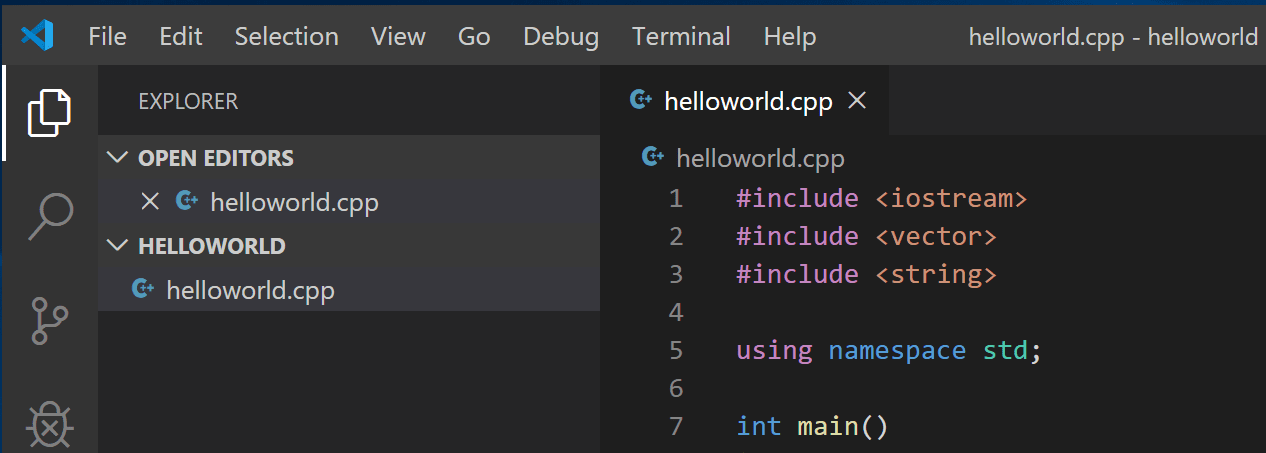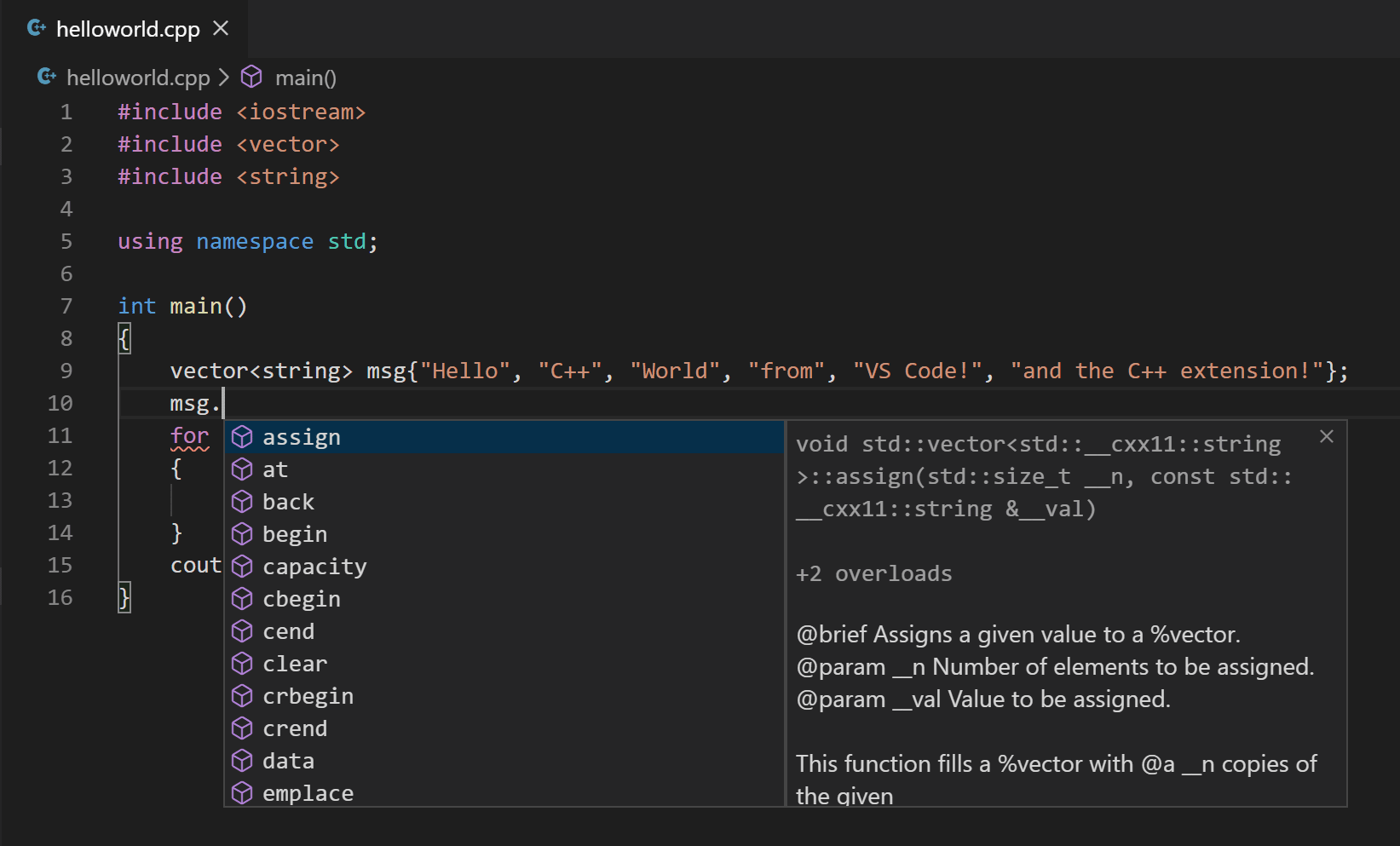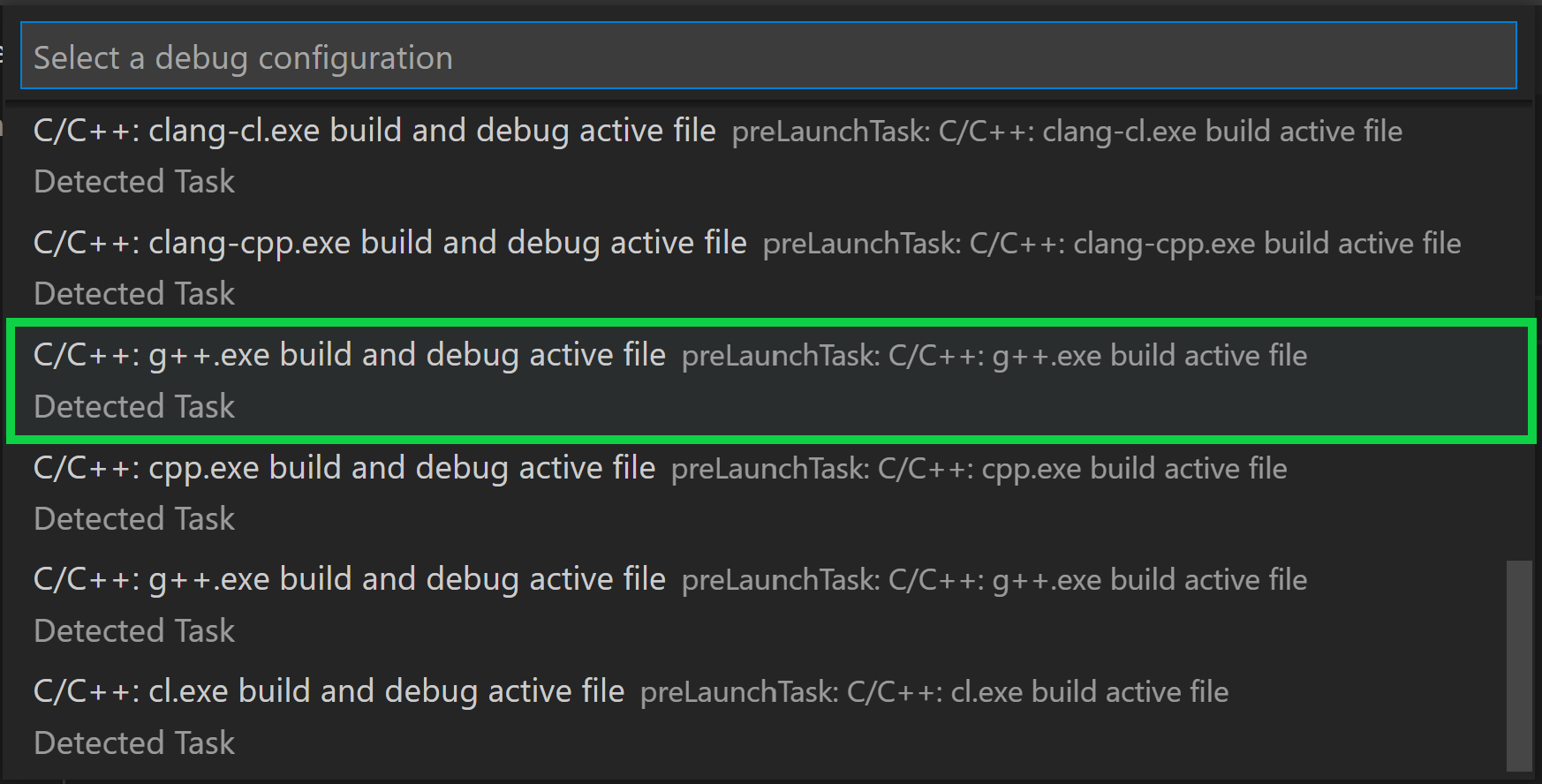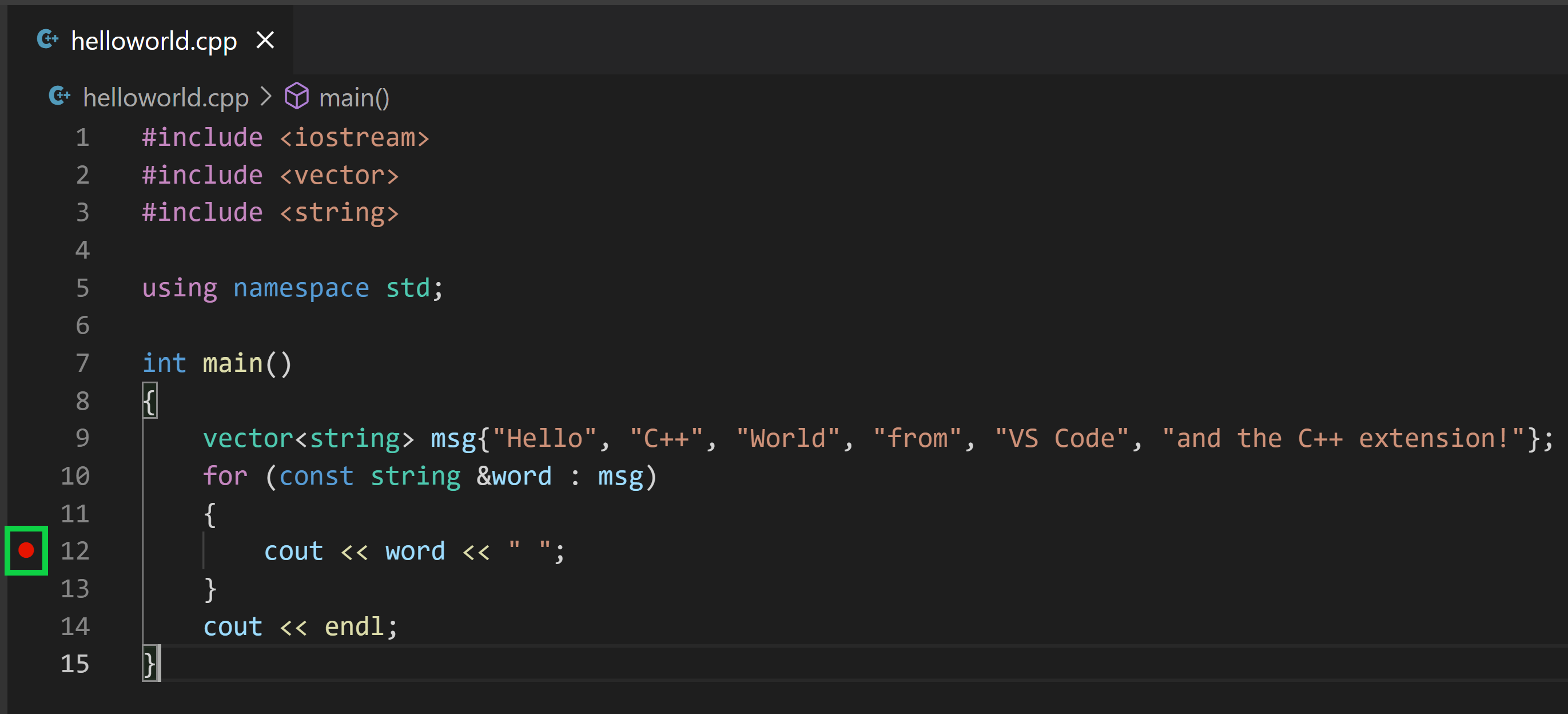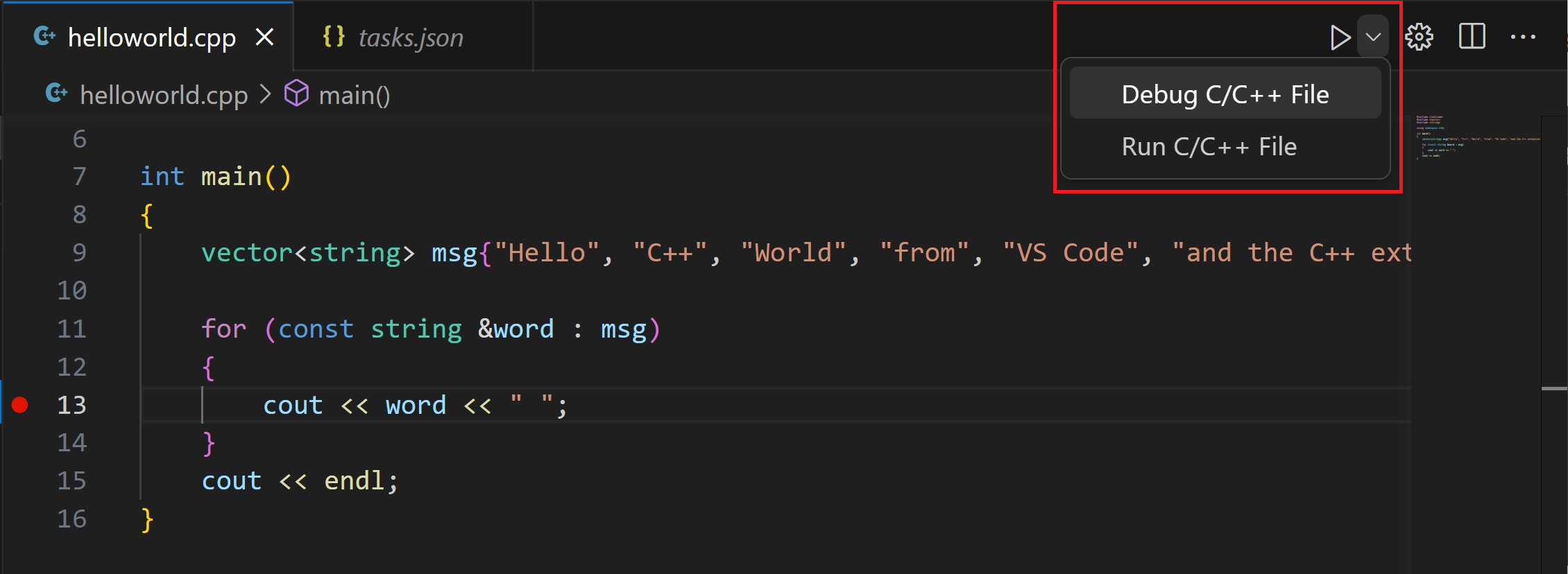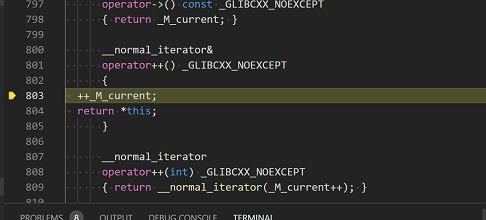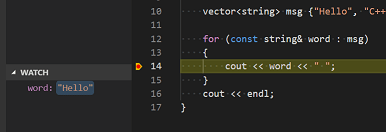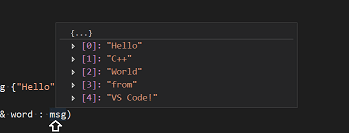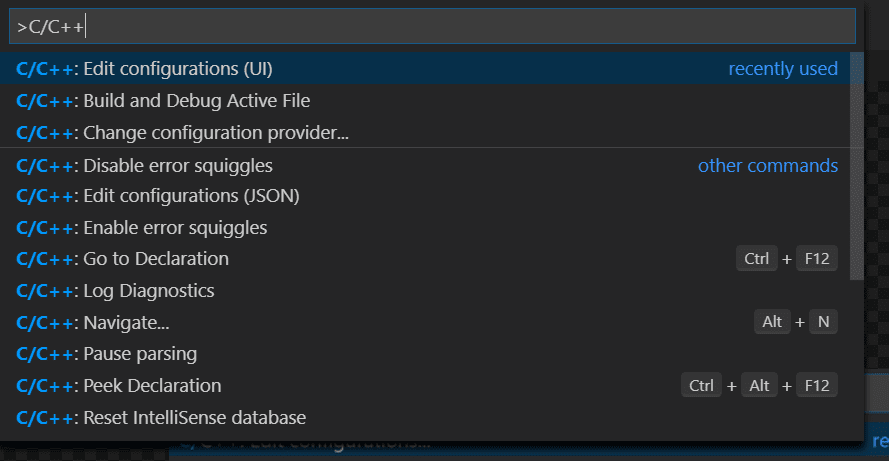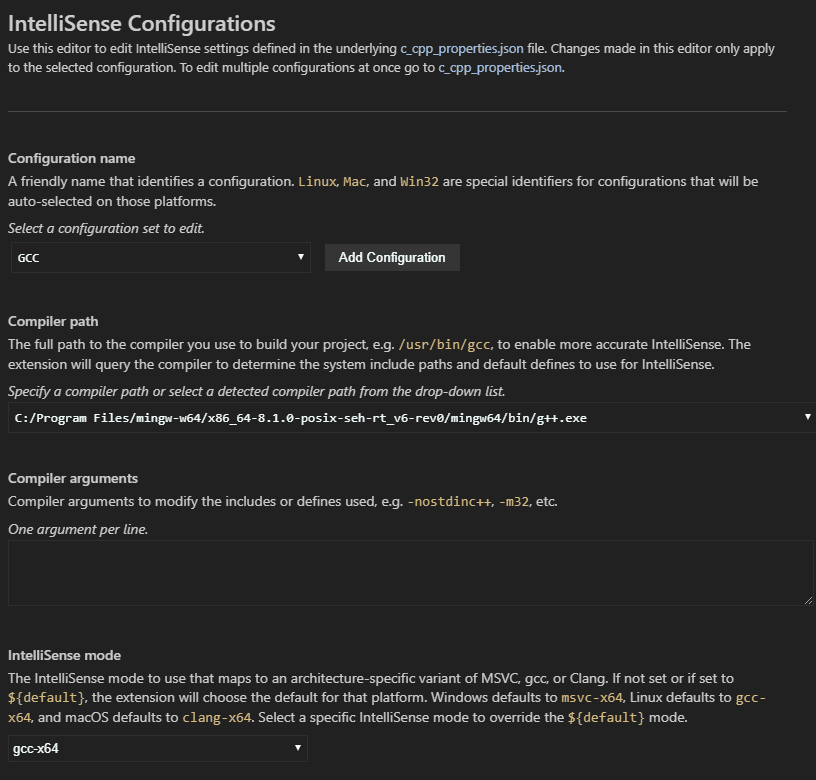Installation
To check if GCC already exists by running the following command in your command promt gcc -v
-
Install MSYS2 MSYS2.
-
This will install the linux shell on your Machine.
-
Update packages and mirrors using
pacman -Syu. -
You may have to restart
-
To install GCC copy the following code and paste in the shell
Ctrl + vmight not work -
Note: Keep pressing ENTER to select the default installation instructions.
pacman -S --needed base-devel mingw-w64-i686-toolchain mingw-w64-x86_64-toolchain \git subversion mercurial \mingw-w64-i686-cmake mingw-w64-x86_64-cmake
- This command will take a while to download and install all files.
- After this GCC is installed but you still need to add it to your path.
- Note: IF you get the following error
gcc is not recognized as an internal or external commandGCC may not be added to your path
PATH
-
To set the path to GCC Compiler
-
Open Start and type
environment variables -
Click
Advanced System Settings -
Click
Environment Variables -
In the
System variablessection add a new entry toPATH/Path. -
Add the following two lines
-
C:\msys64\mingw64\binandC:\msys64\ming32\bin -
Note: The path may vary according to where you have installed MSYS2
-
GCC installation is complete you may use gcc to compile programs
If you still get this error
gcc is not recognized as an internal or external command
try this
Compiling
Locate your program
I will be giving this example considering .c program
cd into your desired directory where file is locate or type cmd in the adress bar
then type command
gcc -o name name.c
eg. gcc -o helloworld helloworld.c
The name after -o is the name given to exe file that is generated
Correct errors if any and run the above command again when done
If no errors are generated
Type name that is the name of your .exe
the program will have run
CODE::BLOCKS
You could also download CODE::BLOCKS IDE which comes with the GCC compiler
Download the binary release from here
Download the one that says mingw-setup.exe
Make sure that you dont have gcc previously installed in your computer
Follow the instructions
You will have to set the path manually as we did previously
The bin lies in C:\Program Files(x86)|CodeBlocks\MinGW\bin
MinGW
MSYS2
GCC
CodeBlocks
More
Installing CodeBlocks
Thank you
To install the GCC compiler, you must first add it to the PATH environment variable in your PC. If you have already installed GCC, you do not need to do this. The bin folder contains executable files of the compiler. Next, you need to install g++. Once you’ve completed these steps, GCC should be automatically installed on your PC. Now, you can use it to compile and run C programs.
Once the installation is complete, you can run Cygwin to download the latest version of GCC. After installing the compiler, you should run the program to test its installation. Make sure that you’ve specified the correct path, as it will determine which versions of GCC are installed. If the installer doesn’t tell you where to find these versions, try re-running it. If the installation is successful, you should be able to run it with the GCC command.
Once you’ve finished installing GCC on Ubuntu, you can compile your C code. Type “gcc -v” into the command prompt to check for the version. The output should be something like fatal error – there’s no input file. If the error message says ‘gcc isn’t installed properly on your PC, your computer doesn’t have gcc. To test if your system is compatible with GCC, run the following command.
Are you looking for instructions on how to install the ‘C’ compiler GCC on Windows? The good news is that there is a very simple way to do so. All you have to do is download and install the GCC compiler, and then run it. Once installed, GCC will work with a wide variety of operating systems and applications. Listed below are some steps to follow. Read on to learn more!
First, extract the downloaded package. To do this, you’ll need Windows XP or higher. Once extracted, open the file with a file-extraction utility, such as WinZip. The file will contain a directory named gcc, along with many other directories. To install GCC, simply click the ‘Open’ button on any of the two windows-based installation dialog windows.
Next, add the GCC compiler to your PC’s PATH environment variable. This step is required if you want to use GCC in your Windows-based applications. The GCC compiler is located in this folder. Make sure you have enough space on your computer. It will take a few seconds to copy and paste the file to the terminal window. If you’ve done this correctly, you should see a new window in the command prompt.
How Do I Install GCC on Windows 11?
Using Cygwin, you can build the GCC compiler on your PC. Cygwin is a command line tool that downloads the source code for the GCC compiler and builds it in C++14 mode. You can install the Cygwin packages from the Windows Store and follow the steps provided by the installation wizard to complete the process. The installation process will take a few minutes, but the benefits of using this tool far outweigh the disadvantages of installing GCC.
To install the compiler, you should first open File Explorer and navigate to the bin folder. You can open File Explorer by pressing the Windows + E keys at the same time. Next, you must find the Environment Variables, Path, and Path under the User Variables and Environment Variables sections. Click the checkbox next to the path to the folder where you want to install GCC. After doing this, you must install the compiler on Windows 11.
Is MinGW And Gcc Same?
To begin with, we should discuss the difference between MinGW and GCC. MinGW is a collection of advancement instruments which incorporates GCC, a C compiler, and Cygwin, a Unix-like climate and order line interface for Windows. GCC is a more powerful programming language, and is the preferred choice for C programs. If you are unsure whether the two programs are the same, here’s an overview.
The MinGW installation process involves installing the MinGW compiler, which includes GCC, C++, and the Binutils tools. This installation process will fail if the “bin” folder is not included in the User Path environment variable. To fix this, go to Start > Properties. Select Advanced system settings. The Environment Variables section will reveal the user path to the GCC installation. Make sure you do not modify this system environment variable because it may affect the proper functioning of your system.
MinGW supports both dynamic and static libraries. MinGW libraries are named using the lib name.a naming convention common in Unix-like systems. Its headers and static import libraries are released under GNU General Public License. Binary downloads are available for MinGW. The MinGW mailing list provides more detailed information. The mailing list contains discussion threads and FAQs. Those with experience with MinGW can share their insights.
How Do You Install Gcc in Windows 10 Using Cmd?
First of all, you must add GCC to your PATH environment variable. To do so, go to Control Panel > Advanced System Settings. Next, click on the Environment Variables tab. Type gcc -version into the command prompt. This should bring up the gcc executable in the bin folder. If you encounter any problems, you can select auto-detect and toolchain executables to fix the problem.
After installing GCC, you should update the package information by clicking on the ‘update’ button. This will download updated versions of the packages from the sources you have configured. You may want to pause the compilation process if you don’t need to use them right away. The new GCC compiler will then be installed and ready for use. It will take a few minutes to install. If it takes too long, you can retry the process.
After installing GCC, you can use it to compile your own programs. You can download the source code of GCC from the Internet or from an official repository. You can choose the latest version of GCC or another version. Make sure to use the latest Cygwin packages. Once you have the latest version, you can start programming in your PC. You will be amazed at how easy it is to install free software.
How Do I Install Gcc on MinGW?
You may have heard of the MinGW project. If you’re curious how this project works, then read on. Essentially, this project uses a dedicated package manager, called mingw-get. Afterwards, you can launch it from the applications menu and install GCC. GCC stands for GNU C++ compiler. Afterwards, you can use mingw-get to add other packages, too.
First, open the MinGW installer, which should be located in your downloads folder. Double-click the installer, and then select Advanced system settings. Under System Variables, find PATH, and click Edit. Then, select New System Variable, and click OK. Finally, run gcc to verify the installation. The mingw installation will be visible, so check it out and use it if needed.
Once you’ve installed MinGW, you can start building and using your code. You can then install the required components, such as GCC and Clang, and use them to create programs. MinGW is easy to install and requires a regular user account. Once installed, use the command g++ –version to test the latest version of the C++ compiler. This command should work on all directories in your computer.
Where is Gcc Path in Windows?
You will first need to extract the package. If you’re using Windows XP, you can use WinZip to do this. Once extracted, the package will contain a directory named gcc and several other directories. The contents of C:Program Filesgcc will be displayed in the screenshot below. You can also edit the environment variable by opening the Control Panel and clicking on System. Once the System properties window has loaded, go to the Advanced tab. Click on Environment Variables and then on the gcc variable.
Alternatively, you can add a prefix called sysroot to the PATH environment variable to make GCC recognize c:/foo/bar/root as the start of the path. However, this won’t fix the original bug in GCC. Those DOS-style paths make it difficult for GCC to recognize them. To get around this, you can use a function called update_path(). The update-path() function replaces ‘/’ with ”.
How Do I Know If Gcc is Installed on Windows?
To check if GCC is installed on Windows, you should use the Cygwin command to download and install the latest version. Once installed, you can run the compiler to check whether it has been successfully installed. If not, you can re-run the command to download and install the latest version of GCC. Alternatively, you can install Cygwin in another location and use it to compile the latest version of GCC on Windows.
To find out if GCC is installed on your PC, open the command prompt and type cmd. If you see two files, they are the right versions of GCC. The correct version will be found in the directory that contains the two files. You can also open the command prompt in a separate window to check if GCC is installed on Windows. However, if GCC is not installed on your PC, you can use the command line to install it.
To find out which version of GCC is installed on Windows, type gcc -v in the command prompt to see if it is present. If it is present, you can try to compile a program and see if it works. If it fails, it will give you a fatal error, because it can’t find an input file. However, if it works fine, then it is installed.
Learn More Here:
1.) Windows Help Center
2.) Windows – Wikipedia
3.) Windows Blog
4.) Windows Central
Using GCC with MinGW
In this tutorial, you configure Visual Studio Code to use the GCC C++ compiler (g++) and GDB debugger from mingw-w64 to create programs that run on Windows. After configuring VS Code, you will compile, run, and debug a simple Hello World program.
This tutorial does not teach you about GCC, GDB, minGW-w64, or the C++ language. For those subjects, there are many good resources available on the Web.
If you have any problems, feel free to file an issue for this tutorial in the VS Code documentation repository.
Prerequisites
To successfully complete this tutorial, you must do the following steps:
-
Install Visual Studio Code.
-
Install the C/C++ extension for VS Code. You can install the C/C++ extension by searching for ‘C++’ in the Extensions view (⇧⌘X (Windows, Linux Ctrl+Shift+X)).
Get the latest version of MinGW-w64 via MSYS2, which provides up-to-date native builds of GCC, MinGW-w64, and other helpful C++ tools and libraries. This will provide you with the necessary tools to compile your code, debug it, and configure it to work with IntelliSense.
-
You can download the latest installer from the MSYS2 page or use this direct link to the installer.
-
Run the installer and follow the steps of the installation wizard. Note that MSYS2 requires 64 bit Windows 8.1 or newer.
-
In the wizard, choose your desired Installation Folder. Record this directory for later. In most cases, the recommended directory is acceptable. The same applies when you get to setting the start menu shortcuts step. When complete, ensure the Run MSYS2 now box is checked and select Finish. This will open a MSYS2 terminal window for you.
-
In this terminal, install the MinGW-w64 toolchain by running the following command:
pacman -S --needed base-devel mingw-w64-ucrt-x86_64-toolchain -
Accept the default number of packages in the
toolchaingroup by pressing Enter. -
Enter
Ywhen prompted whether to proceed with the installation. -
Add the path to your MinGW-w64
binfolder to the WindowsPATHenvironment variable by using the following steps:- In the Windows search bar, type Settings to open your Windows Settings.
- Search for Edit environment variables for your account.
- In your User variables, select the
Pathvariable and then select Edit. - Select New and add the MinGW-w64 destination folder you recorded during the installation process to the list. If you used the default settings above, then this will be the path:
C:\msys64\ucrt64\bin. - Select OK to save the updated PATH. You will need to reopen any console windows for the new PATH location to be available.
Check your MinGW installation
To check that your MinGW-w64 tools are correctly installed and available, open a new Command Prompt and type:
gcc --version
g++ --version
gdb --version
You should see output that states which versions of GCC, g++ and GDB you have installed. If this is not the case:
- Make sure your PATH variable entry matches the MinGW-w64 binary location where the toochain was installed. If the compilers do not exist at that PATH entry, make sure you followed the previous instructions.
- If
gcchas the correct output but notgdb, then you need to install the packages you are missing from the MinGW-w64 toolset.- If on compilation you are getting the «The value of miDebuggerPath is invalid.» message, one cause can be you are missing the
mingw-w64-gdbpackage.
- If on compilation you are getting the «The value of miDebuggerPath is invalid.» message, one cause can be you are missing the
Create a Hello World app
First, lets get a project set up.
- Launch a Windows command prompt (Enter Windows command prompt in the Windows search bar), then
- Run the following commands. These will create an empty folder called
projectswhere you can place all your VS Code projects. There, the next commands will create and navigate to a sub-folder calledhelloworld. From there, you will openhelloworlddirectly in VS Code.
mkdir projects
cd projects
mkdir helloworld
cd helloworld
code .
The «code .» command opens VS Code in the current working folder, which becomes your «workspace». Accept the Workspace Trust dialog by selecting Yes, I trust the authors since this is a folder you created.
As you go through the tutorial, you will see three files created in a .vscode folder in the workspace:
tasks.json(build instructions)launch.json(debugger settings)c_cpp_properties.json(compiler path and IntelliSense settings)
Add a source code file
In the File Explorer title bar, select the New File button and name the file helloworld.cpp.
Add hello world source code
Now paste in this source code:
#include <iostream>
#include <vector>
#include <string>
using namespace std;
int main()
{
vector<string> msg {"Hello", "C++", "World", "from", "VS Code", "and the C++ extension!"};
for (const string& word : msg)
{
cout << word << " ";
}
cout << endl;
}
Now press ⌘S (Windows, Linux Ctrl+S) to save the file. Notice how the file you just added appears in the File Explorer view (⇧⌘E (Windows, Linux Ctrl+Shift+E)) in the side bar of VS Code:
You can also enable Auto Save to automatically save your file changes, by selecting File > Auto Save. You can find out more about the other views in the VS Code User Interface documentation.
Note: When you save or open a C++ file, you may see a notification from the C/C++ extension about the availability of an Insiders version, which lets you test new features and fixes. You can ignore this notification by selecting the
X(Clear Notification).
Explore IntelliSense
IntelliSense is a tool to help you code faster and more efficently by adding code editing features such as code completion, parameter info, quick info, and member lists.
To see IntelliSense in action,
hover over vector or string to see their type information. If you type msg. in line 10, you can see a completion list of recommended member functions to call, all generated by IntelliSense:
You can press the Tab key to insert a selected member. If you then add open parenthesis, IntelliSense will show information on which arguments are required.
If IntelliSense is not already configured, open the Command Palette (⇧⌘P (Windows, Linux Ctrl+Shift+P)) and enter Select IntelliSense Configuration. From the dropdown of compilers, select Use gcc.exe to configure.
Run helloworld.cpp
Remember, the C++ extension uses the C++ compiler you have installed on your machine to build your program. Make sure you have completed the «Installing the MinGW-w64 toolchain» step before attempting to run and debug helloworld.cpp in VS Code.
-
Open
helloworld.cppso that it is the active file. -
Press the play button in the top right corner of the editor.
-
Choose C/C++: g++.exe build and debug active file from the list of detected compilers on your system.
You’ll only be asked to choose a compiler the first time you run helloworld.cpp. This compiler will be set as the «default» compiler in tasks.json file.
-
After the build succeeds, your program’s output will appear in the integrated Terminal.
Congratulations! You’ve just run your first C++ program in VS Code!
Understanding tasks.json
The first time you run your program, the C++ extension creates a tasks.json file, which you’ll find in your project’s .vscode folder. tasks.json stores your build configurations.
Your new tasks.json file should look similar to the JSON below:
{
"tasks": [
{
"type": "cppbuild",
"label": "C/C++: g++.exe build active file",
"command": "C:\\msys64\\ucrt64\\bin\\g++.exe",
"args": [
"-fdiagnostics-color=always",
"-g",
"${file}",
"-o",
"${fileDirname}\\${fileBasenameNoExtension}.exe"
],
"options": {
"cwd": "${fileDirname}"
},
"problemMatcher": ["$gcc"],
"group": {
"kind": "build",
"isDefault": true
},
"detail": "Task generated by Debugger."
}
],
"version": "2.0.0"
}
Note: You can learn more about
tasks.jsonvariables in the variables reference.
The command setting specifies the program to run; in this case that is g++.
The args array specifies the command-line arguments that will be passed to g++. These arguments are listed in this file in the specific order expected by the compiler.
This task tells g++ to take the active file (${file}), compile it, and create an executable file in the current directory (${fileDirname}) with the same name as the active file but with the .exe extension (${fileBasenameNoExtension}.exe). For us, this results in helloworld.exe.
The label value is what you will see in the tasks list; you can name this whatever you like.
The detail value is what you will as the description of the task in the tasks list. It’s highly recommended to rename this value to differentiate it from similar tasks.
From now on, the play button will read from tasks.json to figure out how to build and run your program. You can define multiple build tasks in tasks.json, and whichever task is marked as the default will be used by the play button. In case you need to change the default compiler, you can run Tasks: Configure Default Build Task in the Command Palette. Alternatively you can modify the tasks.json file and remove the default by replacing this segment:
"group": {
"kind": "build",
"isDefault": true
},
with this:
"group": "build",
Modifying tasks.json
You can modify your tasks.json to build multiple C++ files by using an argument like "${workspaceFolder}/*.cpp" instead of ${file}.This will build all .cpp files in your current folder. You can also modify the output filename by replacing "${fileDirname}\\${fileBasenameNoExtension}.exe" with a hard-coded filename (for example "${workspaceFolder}\\myProgram.exe").
Debug helloworld.cpp
To debug your code,
-
Go back to
helloworld.cppso that it is the active file. -
Set a breakpoint by clicking on the editor margin or using F9 on the current line.
-
From the drop-down next to the play button, select Debug C/C++ File.
-
Choose C/C++: g++ build and debug active file from the list of detected compilers on your system (you’ll only be asked to choose a compiler the first time you run or debug
helloworld.cpp).
The play button has two modes: Run C/C++ File and Debug C/C++ File. It will default to the last-used mode. If you see the debug icon in the play button, you can just select the play button to debug, instead of using the drop-down.
Explore the debugger
Before you start stepping through the code, let’s take a moment to notice several changes in the user interface:
-
The Integrated Terminal appears at the bottom of the source code editor. In the Debug Output tab, you see output that indicates the debugger is up and running.
-
The editor highlights the line where you set a breakpoint before starting the debugger:
-
The Run and Debug view on the left shows debugging information. You’ll see an example later in the tutorial.
-
At the top of the code editor, a debugging control panel appears. You can move this around the screen by grabbing the dots on the left side.
Step through the code
Now you’re ready to start stepping through the code.
-
Click or press the Step over icon in the debugging control panel.
This will advance program execution to the first line of the for loop, and skip over all the internal function calls within the
vectorandstringclasses that are invoked when themsgvariable is created and initialized. Notice the change in the Variables window on the left.In this case, the errors are expected because, although the variable names for the loop are now visible to the debugger, the statement has not executed yet, so there is nothing to read at this point. The contents of
msgare visible, however, because that statement has completed. -
Press Step over again to advance to the next statement in this program (skipping over all the internal code that is executed to initialize the loop). Now, the Variables window shows information about the loop variables.
-
Press Step over again to execute the
coutstatement. (Note that as of the March 2019 release, the C++ extension does not print any output to the Debug Console until the loop exits.) -
If you like, you can keep pressing Step over until all the words in the vector have been printed to the console. But if you are curious, try pressing the Step Into button to step through source code in the C++ standard library!
To return to your own code, one way is to keep pressing Step over. Another way is to set a breakpoint in your code by switching to the
helloworld.cpptab in the code editor, putting the insertion point somewhere on thecoutstatement inside the loop, and pressing F9. A red dot appears in the gutter on the left to indicate that a breakpoint has been set on this line.Then press F5 to start execution from the current line in the standard library header. Execution will break on
cout. If you like, you can press F9 again to toggle off the breakpoint.When the loop has completed, you can see the output in the Integrated Terminal, along with some other diagnostic information that is output by GDB.
Set a watch
Sometimes you might want to keep track of the value of a variable as your program executes. You can do this by setting a watch on the variable.
-
Place the insertion point inside the loop. In the Watch window, click the plus sign and in the text box, type
word, which is the name of the loop variable. Now view the Watch window as you step through the loop. -
Add another watch by adding this statement before the loop:
int i = 0;. Then, inside the loop, add this statement:++i;. Now add a watch forias you did in the previous step. -
To quickly view the value of any variable while execution is paused on a breakpoint, you can hover over it with the mouse pointer.
Customize debugging with launch.json
When you debug with the play button or F5, the C++ extension creates a dynamic debug configuration on the fly.
There are cases where you’d want to customize your debug configuration, such as specifying arguments to pass to the program at runtime. You can define custom debug configurations in a launch.json file.
To create launch.json, choose Add Debug Configuration from the play button drop-down menu.
You’ll then see a dropdown for various predefined debugging configurations. Choose C/C++: g++.exe build and debug active file.
VS Code creates a launch.json file in the .vscode folder`, which looks something like this:
{
"configurations": [
{
"name": "C/C++: g++.exe build and debug active file",
"type": "cppdbg",
"request": "launch",
"program": "${fileDirname}\\${fileBasenameNoExtension}.exe",
"args": [],
"stopAtEntry": false,
"cwd": "${fileDirname}",
"environment": [],
"externalConsole": false,
"MIMode": "gdb",
"miDebuggerPath": "C:\\msys64\\ucrt64\\bin\\gdb.exe",
"setupCommands": [
{
"description": "Enable pretty-printing for gdb",
"text": "-enable-pretty-printing",
"ignoreFailures": true
},
{
"description": "Set Disassembly Flavor to Intel",
"text": "-gdb-set disassembly-flavor intel",
"ignoreFailures": true
}
],
"preLaunchTask": "C/C++: g++.exe build active file"
}
],
"version": "2.0.0"
}
In the JSON above, program specifies the program you want to debug. Here it is set to the active file folder (${fileDirname}) and active filename with the .exe extension (${fileBasenameNoExtension}.exe), which if helloworld.cpp is the active file will be helloworld.exe. The args property is an array of arguments to pass to the program at runtime.
By default, the C++ extension won’t add any breakpoints to your source code and the stopAtEntry value is set to false.
Change the stopAtEntry value to true to cause the debugger to stop on the main method when you start debugging.
From now on, the play button and F5 will read from your
launch.jsonfile when launching your program for debugging.
Adding additional C/C++ settings
If you want more control over the C/C++ extension, you can create a c_cpp_properties.json file, which will allow you to change settings such as the path to the compiler, include paths, C++ standard (default is C++17), and more.
You can view the C/C++ configuration UI by running the command C/C++: Edit Configurations (UI) from the Command Palette (⇧⌘P (Windows, Linux Ctrl+Shift+P)).
This opens the C/C++ Configurations page. When you make changes here, VS Code writes them to a file called c_cpp_properties.json in the .vscode folder.
Here, we’ve changed the Configuration name to GCC, set the Compiler path dropdown to the g++ compiler, and the IntelliSense mode to match the compiler (gcc-x64).
Visual Studio Code places these settings in .vscode\c_cpp_properties.json. If you open that file directly, it should look something like this:
{
"configurations": [
{
"name": "GCC",
"includePath": ["${workspaceFolder}/**"],
"defines": ["_DEBUG", "UNICODE", "_UNICODE"],
"windowsSdkVersion": "10.0.22000.0",
"compilerPath": "C:/msys64/mingw64/bin/g++.exe",
"cStandard": "c17",
"cppStandard": "c++17",
"intelliSenseMode": "windows-gcc-x64"
}
],
"version": 4
}
You only need to add to the Include path array setting if your program includes header files that are not in your workspace or in the standard library path.
Compiler path
The extension uses the compilerPath setting to infer the path to the C++ standard library header files. When the extension knows where to find those files, it can provide features like smart completions and Go to Definition navigation.
The C/C++ extension attempts to populate compilerPath with the default compiler location based on what it finds on your system. The extension looks in several common compiler locations.
The compilerPath search order is:
- First check for the Microsoft Visual C++ compiler
- Then look for g++ on Windows Subsystem for Linux (WSL)
- Then g++ for MinGW-w64.
If you have Visual Studio or WSL installed, you may need to change compilerPath to match the preferred compiler for your project. For example, if you installed MinGW-w64 version 8.1.0 using the i686 architecture, Win32 threading, and sjlj exception handling install options, the path would look like this: C:\Program Files (x86)\mingw-w64\i686-8.1.0-win32-sjlj-rt_v6-rev0\mingw64\bin\g++.exe.
Troubleshooting
MSYS2 is installed, but g++ and gdb are still not found
You must follow the steps on the MSYS2 website to use the MSYS CLI to install the full MinGW-w64 toolchain(pacman -S --needed base-devel mingw-w64-ucrt-x86_64-toolchain), as well as all required prerequisites. The toolchain includes g++ and gdb.
As a Windows user, running the pacman command gives me an error
UCRT on Windows machines is only included in Windows 10 or later. If you are using another version of Windows, run the following command that does not use UCRT:
pacman -S --needed base-devel mingw-w64-x86_64-toolchain
When adding the the MinGW-w64 destination folder to your list of environment variables, the default path will then be: C:\msys64\mingw64\bin.
MinGW 32-bit
If you need a 32-bit version of the MinGW toolset, consult the Downloading section on the MSYS2 wiki. It includes links to both 32-bit and 64-bit installation options.
Next steps
- Explore the VS Code User Guide.
- Review the Overview of the C++ extension.
- Create a new workspace, copy your
.vscodeJSON files to it, adjust the necessary settings for the new workspace path, program name, etc. and start coding!
7/14/2023
I am using Visual Studio Code on Windows 10 and I am trying to build a program (called Bus from the source file Bus.cpp) with g++ from MinGW. I modified the tasks.json file using various methods that I have read from previous threads. I am providing screenshots of the tasks.json file and the results after building (ctrl + shift + b). I am also providing my questions below.
Method 1
Method 2
Method 3
Method 4
Question 1) I want to be able to build and create a program called «bus» using method 1. However, I have to replace «g++» with the directory path of the MinGW’s g++ compiler (as shown in method 2). What do I have to do in order to just put «g++» instead of the path to MinGW’s g++.exe?
Question 2) It looks like it compiled using methods 2 and 4 which provide the directory path to MinGW’s g++ compiler but I do not see the built program called «bus» even though I used «-o bus» in the command. Why do I not see it?
EDIT TO SHOW CODES:
First Method tasks.json file:
{
// See https://go.microsoft.com/fwlink/?LinkId=733558
// for the documentation about the tasks.json format
"version": "2.0.0",
"tasks": [
{
"label": "build",
"type": "shell",
"command": "g++ -g bus.cpp -o bus",
"group": {
"kind": "build",
"isDefault": true
}
}
]
}
First Method resulting output:
> Executing task: g++ -g bus.cpp -o bus <
g++ : The term 'g++' is not recognized as the name of a cmdlet, function, script file, or operable program. Check the spelling of the name,
or if a path was included, verify that the path is correct and try again.
At line:1 char:1
+ g++ -g bus.cpp -o bus
+ ~~~
+ CategoryInfo : ObjectNotFound: (g++:String) [], CommandNotFoundException
+ FullyQualifiedErrorId : CommandNotFoundException
The terminal process terminated with exit code: 1
Terminal will be reused by tasks, press any key to close it.
Second Method tasks.json file:
{
// See https://go.microsoft.com/fwlink/?LinkId=733558
// for the documentation about the tasks.json format
"version": "2.0.0",
"tasks": [
{
"label": "build",
"type": "shell",
"command": "C:/MinGW/bin/g++.exe -g bus.cpp -o bus",
"group": {
"kind": "build",
"isDefault": true
}
}
]
}
Second Method resulting output:
> Executing task: C:/MinGW/bin/g++.exe -g bus.cpp -o bus <
The terminal process terminated with exit code: 1
Terminal will be reused by tasks, press any key to close it.
Third Method tasks.json file:
{
// See https://go.microsoft.com/fwlink/?LinkId=733558
// for the documentation about the tasks.json format
"version": "2.0.0",
"tasks": [
{
"label": "build",
"type": "shell",
"command": "g++",
"args": [
"-g", "bus.cpp", "-o", "bus"
],
"group": {
"kind": "build",
"isDefault": true
}
}
]
}
Third Method resulting output:
> Executing task: g++ -g bus.cpp -o bus <
g++ : The term 'g++' is not recognized as the name of a cmdlet, function, script file, or operable program. Check the spelling of the name,
or if a path was included, verify that the path is correct and try again.
At line:1 char:1
+ g++ -g bus.cpp -o bus
+ ~~~
+ CategoryInfo : ObjectNotFound: (g++:String) [], CommandNotFoundException
+ FullyQualifiedErrorId : CommandNotFoundException
The terminal process terminated with exit code: 1
Terminal will be reused by tasks, press any key to close it.
Fourth Method tasks.json file:
{
// See https://go.microsoft.com/fwlink/?LinkId=733558
// for the documentation about the tasks.json format
"version": "2.0.0",
"tasks": [
{
"label": "build",
"type": "shell",
"command": "C:/MinGW/bin/g++",
"args": [
"-g", "bus.cpp", "-o", "bus"
],
"group": {
"kind": "build",
"isDefault": true
}
}
]
}
Fourth Method resulting output:
> Executing task: C:/MinGW/bin/g++ -g bus.cpp <
The terminal process terminated with exit code: 1
Terminal will be reused by tasks, press any key to close it.
GCC is a compiler used to create binaries for Windows 10. It can be downloaded from the GCC website or from the Microsoft Download Center. The installation process is simple and takes only a few minutes.
Once GCC has been installed, it can be used to compile and install programs on Windows 10. To start compilation, open a command prompt and type gcc . This will start the compiler and allow you to create files and folders.
Next, you will need to add the gcc executable to your PATH environment variable. To do this, type setenv PATH “C:\Program Files (x86)\GCC\bin” . This will add GCC to your PATH variable so that it can be used when compiling programs.
To build a program, you first need to create a project file in the root of your C:\Program Files (x86)\GCC\src directory. This project file contains information about your program and its dependencies. You can find this file in the same directory as your gcc executable.
Next, you need to generate a source code file for your program. To do this, open an editor such as Notepad or Word and enter the following code into it:
#include #include #include using namespace std; int main(int argc, char **argv) { // Create an instance of our class MyClass; MyClass myClass = new MyClass(); // Compile our program printf(«%s%d», myClass->getName(), myClass->getVersion()); return 0; }
Once the executable files are on your PC, you can install the GCC compiler. The GCC compiler is found in the bin folder, which contains files from several packages. To install GCC on Windows, you can use Cygwin to install it. You should also be able to uninstall Cygwin if you no longer need it. If you wish to install GCC in a different location, you can use the -prefix=/path/to/directory.
If you’re a developer and you want to build your software in a Unix-like environment, you may want to know how to download GCC on Windows 10. To install GCC on Windows, you need to install Cygwin and then add the mingw32/bin folder to your PATH environment variable. If you don’t see this folder in the PATH, you might need to add it yourself.
How Can I Download GCC?Is GCC Available For Windows?Which is the Best GCC Compiler For Windows 10?How Do I Know If Gcc is Installed?How Do I Find Gcc Version in Windows?Is MinGW And Gcc Same?Where is Gcc Located?
To download GCC, open your CMD command-line and type “cmd” into the search bar. Then type gcc in the resulting command window. The GCC executables will be in the bin folder. After installing them, you can try compiling some C programs. You can also use gcc to run programs in C. This is a great way to install the necessary software on Windows.
The GCC installer will install executables in /usr/local/bin. It will also install the static C++ library, compiler, and dependencies. You can also download the Cygwin installer, which can be found in /usr/local/bin. This installer will guide you through the process of installing GCC. If you are a developer, you can also install Cygwin by installing the latest version of Windows.
Is GCC Available For Windows?
If you want to compile your own programs, you’ll probably want to check out the GCC compiler. The GCC compiler is an open source programming language that runs on Windows, Linux, and other platforms. It has been around since 1987 and is compatible with most of these systems. The GCC compiler has been a popular choice for developers since it produces native binaries for many different operating systems. You can install GCC on Windows for a variety of reasons.
Before you install GCC, you’ll need to add it to your PC’s PATH environment variable. To do this, open up the Windows Explorer, then type “env” to see what environment variables you have available. After that, type gcc –version into the Command Promp Terminal. Your PC should now automatically install the GCC compiler. To test whether it is installed, run the helloworld.c program and see if it works.
Which is the Best GCC Compiler For Windows 10?
As one of the most popular programming languages, GCC has many benefits for Windows users. It is a widely used open source compiler that runs on GNU/Linux, Apple macOS, and Windows systems. GCC has been around since 1987, and is compatible with most major operating systems. It allows developers to create windows versions of open-source software, as well as native binaries for several operating systems.
Borland C++ is one of the oldest and cheapest compilers, with a good history of being used on the PC. It provides simple editing features and works well both in Windows and in MS-DOS prompts. Another open-source environment that uses GCC and Cygwin is Dev C++. This is a complete C++ compiler that comes with a Delphi editor. You can use either version to create your applications.
How Do I Know If Gcc is Installed?
If you’re thinking about compiling some code, you should check if you have the correct GCC compiler installed on your Windows 10 system. If it’s not, then you might need to download the source code and compile it yourself. You can find out if GCC is installed by typing “gcc -v” into the command prompt. The output should say “fatal error: no input file” or “gcc version:.”
The GNU Compiler Collections (GCC) is a set of free software programs produced by the GNU Project. It is an essential part of the GNU toolchain, and is used to create various computer programs. It is distributed under the GNU General Public License. Windows 10 users can check if GCC is installed by typing CMD into their command prompt. Once you’ve found the GCC folder, you can continue compiling your programs.
Once you have the GCC compiler installed, you can use it. You can install GCC by using the CMD command line, which will take about 15 minutes. It’s important to install Cygwin to run Unix-like commands on Windows. If you aren’t sure what Cygwin is, you can download it for free. It’s also worth mentioning that it will take a while for the GCC compiler to fully install on Windows 10.
How Do I Find Gcc Version in Windows?
To install GCC on Windows, you must first set up the environment variables. These can be found in Windows Explorer, or in the Command Promp Terminal. To check the GCC compiler version, you can type “gcc -version” into the Command Promp Terminal. After installing GCC, you can check if it’s installed by running gcc.exe in the command line window.
There are many ways to find GCC on Windows. The most obvious way is to open a command line and type gcc -v to find the GCC compiler version. If your system is outdated, you may prefer UCRT (Universal Compiler Runtime) – a free alternative to GCC. For older versions of Windows, though, the command line option is easier to use.
Another way to check the GCC version on Windows 10 is to open the C++ compiler directory. This directory can be found in the /usr/bin directory. If you can’t find the GCC compiler directory, you can use the standard library’s headers to check the GCC version. If the version number is lower, you’ll need to install another C++ library. These steps will take about 15 minutes.
Is MinGW And Gcc Same?
Are MinGW and Gcc the same compiler for Windows 10? GCC is the most popular C++ compiler and MinGW combines both to make the most powerful coding environment on Windows. MinGW includes the entire POSIX build environment, including Make, AutoTools, and more. This combination of tools removes all of the limitations of GCC and opens up the world of open source code development to Windows users.
Before installing the compiler, you must edit the PATH variable on Windows 10. To do this, press the Windows Key + Pause. Then, go to System Control Center. Click on Advanced System Settings. Then, select Environment Variables. To install MinGW-w64, use the MSYS CLI. If you’re running Windows 10, you can also access the MSYS2 wiki.
In the Environment Variables window, type in C:MinGWbin to create a new environment variable. The path will be C:MinGWbin. The Path system variable is an address in which the MinGW bin directory is stored. This path is used by c++ programs. Alternatively, you can open the folder in Visual Studio and select the MinGW bin directory. Both environments have their own benefits and disadvantages.
Where is Gcc Located?
Where is GCC located on Windows 10? GCC is a set of programs produced by the GNU Project that supports various computer languages. It is an essential part of the GNU toolchain and is distributed under the GNU General Public License. Once installed, you can use GCC to create various computer programs. To find the GCC path on Windows 10, type ‘cmd’ into a command window.
If you are unfamiliar with the PATH environment variable, you can add it manually. To install GCC, open the command prompt in Windows Explorer and type ‘gcc’ –version’. After entering the command, the compiler should have been successfully installed. If you encounter an error message, simply close the command prompt and restart your PC. You can also try to locate GCC in the same way. This way, you can check whether GCC is installed in your system.
Once installed, GCC is stored in the /usr/local directory. The /usr/local/bin directory is already listed in the PATH environment variable, so uninstalling GCC from there is difficult. Additionally, /usr/local/bin usually contains a large number of files from several packages. To uninstall GCC, you can add the option -prefix=/path/to/directory to the command line.



